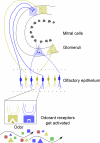Map formation in the olfactory bulb by axon guidance of olfactory neurons
- PMID: 22013417
- PMCID: PMC3190187
- DOI: 10.3389/fnsys.2011.00084
Map formation in the olfactory bulb by axon guidance of olfactory neurons
Abstract
The organization of representations in the brain has been observed to locally reflect subspaces of inputs that are relevant to behavioral or perceptual feature combinations, such as in areas receptive to lower and higher-order features in the visual system. The early olfactory system developed highly plastic mechanisms and convergent evidence indicates that projections from primary neurons converge onto the glomerular level of the olfactory bulb (OB) to form a code composed of continuous spatial zones that are differentially active for particular physico-chemical feature combinations, some of which are known to trigger behavioral responses. In a model study of the early human olfactory system, we derive a glomerular organization based on a set of real-world, biologically relevant stimuli, a distribution of receptors that respond each to a set of odorants of similar ranges of molecular properties, and a mechanism of axon guidance based on activity. Apart from demonstrating activity-dependent glomeruli formation and reproducing the relationship of glomerular recruitment with concentration, it is shown that glomerular responses reflect similarities of human odor category perceptions and that further, a spatial code provides a better correlation than a distributed population code. These results are consistent with evidence of functional compartmentalization in the OB and could suggest a function for the bulb in encoding of perceptual dimensions.
Keywords: axonal guidance; glomeruli; odor category; olfaction; olfactory bulb; olfactory coding; perception; plasticity.
Figures






References
-
- Abbott L. F., Luo S. X. (2007). A step toward optimal coding in olfaction. Nat. Neurosci. 10, 1342–1343 - PubMed
-
- Acree T., Arn H. (1998). “Flavornet: a database of aroma compounds based on odor potency in natural products,” in Food Flavors: Formation, Analysis and Packaging Influences, Proceedings of the 9th International Flavor Conference The George Charalambous Memorial Symposium, Vol. 40, eds Contis E., Ho C.-T., Mussinan C., Parliment T., Shahidi F., Spanie A. (Amsterdam: Elsevier Science), 27
-
- Adam Y., Mizrahi A. (2010). Circuit formation and maintenance – perspectives from the mammalian olfactory bulb. Curr. Opin. Neurobiol. 20, 134–140 - PubMed
-
- Alt H., Knauer C., Wenk C. (2003). Comparison of distance measures for planar curves. Algorithmica 38, 45–5810.1007/s00453-003-1042-5 - DOI
LinkOut - more resources
Full Text Sources
Miscellaneous

